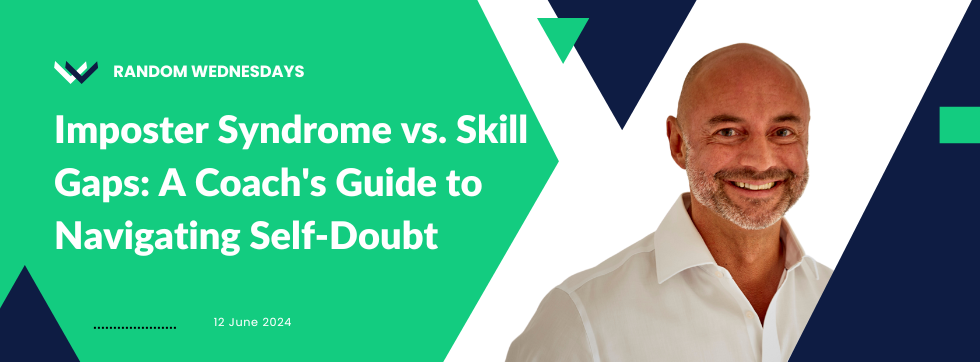Who the hell am I to be coaching an ex-COO of a multi-billion-dollar multinational?
My heart was racing.
Like me you’ve probably experienced moments of self-doubt.
Questioning your coaching abilities despite your experience and expertise.
If so, you’re not alone.
Recognising the difference between imposter syndrome and genuine skill gaps is a crucial distinction in your coaching development.
Today, we’ll explore the key differences.
Providing actionable strategies to help you manage imposter syndrome and identify real areas to improve your skills.
Let’s dive in.
Recognising imposter syndrome
“I don’t belong.”
“What am I doing here?”
“It’s only a matter of time before I get found out”
Imposter syndrome is the experience of feeling like a fraud despite evidence to the contrary.
It’s typified by anxiety, chronic self-doubt and feelings of inadequacy regardless of your success.
Skill gaps, on the other hand are areas where you may need further development to enhance your coaching effectiveness.
Here are 8 tell-tale signs you may be experiencing imposter syndrome:
- Seeking validation
- Feeling inadequate
- Persistent self-doubt
- Hesitating to share ideas
- Struggling to accept praise
- Comparing yourself to others
- Engaging in negative self-talk
- Overworking and perfectionism
If you’re nodding your head or ticking a few off the list, it’s likely you’re experiencing some form of imposter syndrome.
These feelings are common among your peers but don’t reflect your true capabilities as a coach.
Recognising the signs is the first step in overcoming it and building genuine self-assurance.
Identifying genuine skill gaps
Identifying genuine skill gaps in your coaching practice is essential for continuous improvement and ensuring you provide the best service to your clients
Here are 4 ways to spot opportunities to level up:
- Client feedback: Clients may provide constructive feedback or express frustration over lack of progression or not achieving their goals.
- Self-assessment: You feel uncertain in certain situations, or notice recurring challenges, such as supporting people in “victim” mode.
- Peer reviews: Receiving feedback from peers, highlighting specific areas for improvement.
- Performance metrics: Low retention rates or inconsistent client conversions can signal a requirement for skill enhancement.
Some common coaching skill gaps include:
- Asking more powerful questions
- Establishing clearer agreements
- Evoking greater self awareness
- Maintaining a better presence
- Deeper active listening
By identifying and addressing these gaps, you can enhance your coaching effectiveness and serve your clients more powerfully.
Overcoming imposter syndrome
In my own development, I’ve focused my energies on three areas to help combat feelings of imposter syndrome and build my inner confidence.
These are:
- Developing my self-awareness
- Challenging my internal critic
- Celebrating tiny wins
Here are 5 additional strategies my clients have found useful too.
- Acknowledge your feelings: Recognise that imposter syndrome is common and not unique to you.
- Share your experiences: Talk about your feelings with friends, mentors, or colleagues. Sharing can help you realise others may have similar feelings and provide support.
- Keep a success journal: Document breakthroughs and the positive impact of your coaching. This serves as a reminder of your competence and value.
- Practice reframing negative self-talk: Challenge negative thoughts with more balanced, realistic perspectives about your coaching skills.
- Embrace continuous learning: Focus on growth rather than perfection in your coaching practice.
There’s no final destination to get to.
Over time you’ll gradually shift your mindset from self-doubt to self-assurance.
- Believing you belong
- Believing you’re worthy
- Believing you’re the real deal
Addressing skill gaps
Next, create a plan for your professional development.
Here’s how to get started:
- Create a skill acquisition timeline with milestones, accountability
- Research niche-aligned resources, invest in targeted learning
- Break down a skill gap into specific, measurable objectives
- Practice and apply these new techniques with clients
- Celebrate progress and successes along the journey
Be proactive and invest in yourself.
By addressing opportunities to improve you’re more likely to improve your impact as a coach and find ways to reduce feelings of imposter syndrome.
Conclusion
Distinguishing between imposter syndrome and genuine skill gaps is essential for your growth as a professional coach.
By recognizing the signs of each, you can develop self-awareness, challenge limiting beliefs, and create actionable plans to enhance your expertise.
Action step:
- Identify one area where you may be experiencing imposter syndrome or a skill gap. Create a personal action plan to address the issue.
- Break down your goal into specific, measurable objectives, and set a timeline for skill acquisition or mindset shifts.
- Commit to implementing your plan and celebrate your progress along the way.
Remember, your dedication to personal and professional growth sets you apart and is the key to unlock your full potential.


